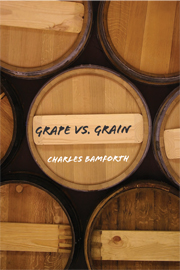Book contents
- Frontmatter
- Contents
- Preface
- Grape vs. Grain
- 1 Beer and Wine: Some Social Commentary
- 2 A Brief History of Wine
- 3 A Brief History of Beer
- 4 How Wine Is Made
- 5 How Beer Is Made
- 6 The Quality of Wine
- 7 The Quality of Beer
- 8 Types of Wine
- 9 Types of Beer
- 10 The Healthfulness of Wine and Beer
- 11 Conclusions about Beer and Wine – and the Future
- Further Reading
- Index
11 - Conclusions about Beer and Wine – and the Future
Published online by Cambridge University Press: 16 September 2009
- Frontmatter
- Contents
- Preface
- Grape vs. Grain
- 1 Beer and Wine: Some Social Commentary
- 2 A Brief History of Wine
- 3 A Brief History of Beer
- 4 How Wine Is Made
- 5 How Beer Is Made
- 6 The Quality of Wine
- 7 The Quality of Beer
- 8 Types of Wine
- 9 Types of Beer
- 10 The Healthfulness of Wine and Beer
- 11 Conclusions about Beer and Wine – and the Future
- Further Reading
- Index
Summary
Joe was one of my best ever students. he thirsted for knowledge of beer. He devoured the literature, attended class compulsively, asked perceptive and passionate questions, and was superlative in the experimental brewery, producing beers of sublime excellence. He also has the word “beer” tattooed across an ample belly in huge gothic script. This says everything really. I cannot imagine the winemakers on campus – seemingly as many women as men – adorning their guts with “Pinot Noir,” even in henna. Perhaps a subtle little tattoo located somewhere tasteful and sophisticated.
Plenty of these winemakers take my beer classes. They accept the well-intentioned teasing, for the most part (as do the chemical engineers, who proudly identify themselves when I go round the class at the start of term, before I remind them that they have no soul and have no grasp of the beauty inherent in biological systems). After about four weeks, as we finally reach yeast and fermentation, I delight in telling the viticulture and enology students that had this been a wine class, we'd have reached the fermenter on day one: “Heck, you just crush a few grapes and you're ready to toss in the yeast – if you bother even to do that. You might always just leave the contaminating microflora to get on with it.”
- Type
- Chapter
- Information
- Grape vs. GrainA Historical, Technological, and Social Comparison of Wine and Beer, pp. 181 - 198Publisher: Cambridge University PressPrint publication year: 2008



